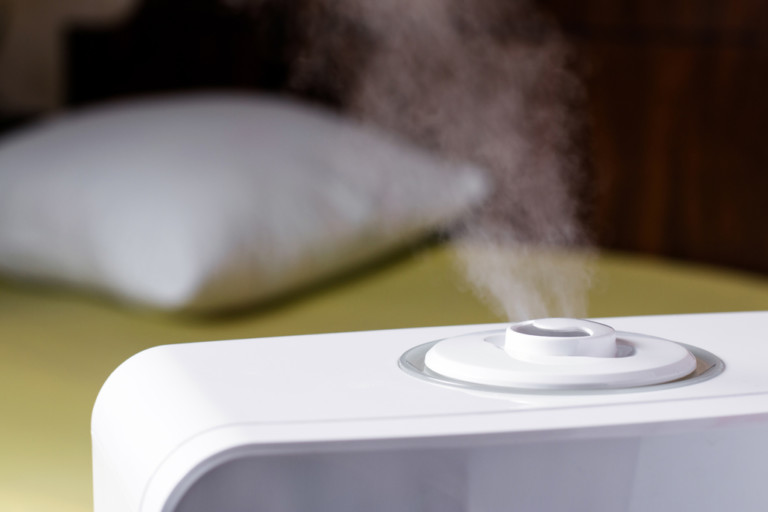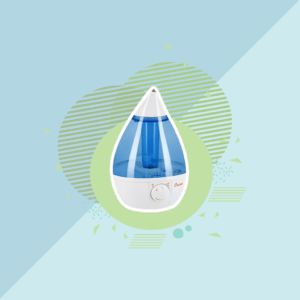Humidifiers vs. Vaporizers
Humidifiers and vaporizers were both developed to to alleviate or eliminate the effects of dry air such as nasal congestion and cough, but both work quite differently to address these problems. In this guide, we’ll walk you through the differences between humidifiers and vaporizers and help you determine which will suit your needs best.
Operation
The main difference between humidifiers and vaporizers is the temperature of their mist: while humidifiers produce cool mist, vaporizers produce warm mist. Beyond that basic distinction, though, and to fully understand how these two appliances work, it’s best to know about the different types of humidifiers and vaporizers.
Types of cool mist humidifiers:
- Evaporative humidifiers – A typical evaporative humidifier uses a fan and a wick filter to operate. Basically, the wick filter absorbs the water in the humidifier’s water tank, and the fan blows air toward the wick causing the water to evaporate into fine mist. What’s great about evaporative humidifiers is that they’re self-regulating, which means they don’t produce any more mist than necessary.
- Ultrasonic humidifiers – An ultrasonic humidifier uses a diaphragm that vibrates at an ultrasonic frequency (thus the name) to create fine water droplets that are released in the form of mist. An ultrasonic humidifier that can emit both warm and cool mist is called a dual mist ultrasonic humidifier.
- Impeller humidifiers – Impeller humidifiers are a lot less common than both evaporative and ultrasonic humidifiers. They use a rotating disc to throw water at a diffuser which breaks the water into very fine droplets that float out into the air. These droplets are then seen as cool mist being released from the humidifier.
Types of vaporizers:
- Steam vaporizers – Steam vaporizers are also known as warm mist humidifiers. They work by boiling or heating water at very high temperatures and then releasing steam and moisture into the air. This type of humidifier releases “cleaner” mist as compared to cool mist humidifiers because bacteria is eliminated during the heating process so you can rest assured that the mist you’re inhaling isn’t contaminated.
- Waterless vaporizers – Waterless vaporizers release warm mist as well but don’t need water to operate. Instead, they use pre-moistened pads which are typically infused with menthol and essential oils. They are less popular: there are only a few waterless humidifiers available in the market today.
Application
Humidifiers and vaporizers are both used to create a more humid environment. Parents, in particular, use these appliances to help their children or infants breathe easier especially if they suffer from respiratory diseases. Humidifiers and vaporizers have long been used to relieve allergy symptoms, asthma, and even bronchitis.
If you’re a parent and you need to use one of these appliances for your children, then we highly recommend choosing a cool mist humidifier over a vaporizer. The problem with vaporizers is that they use a heating element to boil water, making them hazardous to use in a nursery. Vaporizers, however, often come with scented pad slots or medicine cups which allow you to add medicinal inhalants to the steam, which makes them ideal for treating cough and cold symptoms. To ensure safe use of vaporizers around children, adult supervision is imperative.
Ideally, humidifiers and vaporizers are used in shared living spaces where most family members will be able to benefit from them. To maximize their benefit, though, it’s best to have them as close to your breathing space as possible like on a bedside table, office table, or somewhere in your bedroom.
Other applications for humidifiers include wood protection. Dry air can pull any moisture out of your home, and that includes moisture that’s inherent in wood. This can cause the wood to crack and split. Accordingly, having a humidifier or vaporizer in your home can not only benefit your family, but your wooden belongings as well.
Considerations
As with any home appliance, humidifiers and vaporizers have different characteristics that you need to take into consideration before purchasing:
- Cost – In general, humidifiers are more expensive than vaporizers upfront. For evaporative humidifiers that use wick filters, long-term costs continually increase due to the replacement filters which have to be changed as often as once every month, depending on usage. Waterless vaporizers that use pre-moistened pads are also quite expensive long-term. As for energy consumption, steam vaporizers consume more energy due to the heating element.
- Room coverage – Cool mist humidifiers tend to be able to cover larger spaces as opposed to vaporizers, but this depends on the specific brand and the model selected.
- Noise – Evaporative humidifiers are considered the noisiest type of humidifier. All the other types make more or less the same noise levels at full blast. Some claim, though, that vaporizers are significantly quieter than other types.
- Features – Humidifiers and vaporizers have more or less the same features. Common features in these devices include auto shut off, humidistat, maintenance indicators, timer, and more.
- Maintenance – Both humidifiers and vaporizers need to be cleaned before being used. Because they use so much water, they become prime breeding grounds for mold, mildew, and bacteria. When used in an unclean state, there’s a likelihood that the mist they produce could potentially hold harmful bacteria. For more information on how to clean your humidifier/vaporizer, check out our in-depth guide here.
- Safety – Vaporizers have long been considered less safe due to the heating element they use. During operation, certain parts and pieces will get very hot, as does the steam that they produce. This is why vaporizers should be kept away from children and pets and should never be used in nurseries.
Potential Risks
There are several risks that can be involved with using humidifiers and vaporizers. Here are a some examples of potential risks that come with using a humidifier and vaporizer:
- Over-humidifying – When not properly regulated, they can potentially over-humidify a room. Humidity that is too high for too long can lead to several problems, such as mold growth or a proliferation of dust mites around your home. High humidity levels can also cause feelings of discomfort such as stuffiness or can contribute to condensation on walls and windows.
- Allergy triggers from mold and dust mites – Mold and dust mites proliferate in humid environments and can trigger allergic reactions in children who are sensitive to them.
- Breeding ground for bacteria and viruses – When not cleaned regularly, humidifiers and vaporizers become ideal places for bacteria and viruses to grow. These microorganisms can cause illnesses and infections. This is especially true for children because of their underdeveloped immune system.
- White dust – White dust that comes from a humidifier is caused by trace minerals present in the water that you’re using. Ultrasonic humidifiers often have this problem when hard water is being used. To avoid this, distilled or demineralized water should be used.
- Spilled water – It’s no secret that humidifiers are prone to leaking. Leaks can be caused by any number of things, but the most common causes include an overfilled tank, a blocked drainage tube, or a clogged filter. Uncleaned spills can be very dangerous, especially when you have a toddler running around the house who could slip and fall.
- Electrocution – This is probably one of the scariest things that could happen when using humidifiers. With an electric appliance that holds so much water, electrocution is a very real risk. It’s important to check that wires and switches on the humidifier are in good condition and functioning properly. When refilling the humidifier, it’s safer to unplug the unit to prevent any accidents from happening.
- Burns from vaporizers – As discussed previously, warm mist humidifiers pose a safety risk due to the heating element that they use. A warm mist humidifier can get very hot while in use and could potentially burn your curious toddlers when they try to touch it. If you want to be completely safe, then you’re better off with a cool mist humidifier.
Scary as they may seem, these risks can be minimized or eliminated completely when the appliance is well-maintained and regularly cleaned. When in use, it would be ideal to place them in a spot that pets and small children can’t reach.
Final Thoughts
Humidifiers and vaporizers are equally effective at adding moisture to the air. Many experts have debunked the myth that vaporizers are better than humidifiers at alleviating respiratory diseases. This is because the mist will be the same temperature once it reaches your respiratory tract, regardless of whether it started out cool or warm.
With that said, it all boils down to your personal preference, budget, and family considerations. Regardless of which you choose, there’s no denying a humidifier or vaporized will improve the overall quality of the air at home. Just be sure to keep them clean and regularly monitor your humidity levels.




